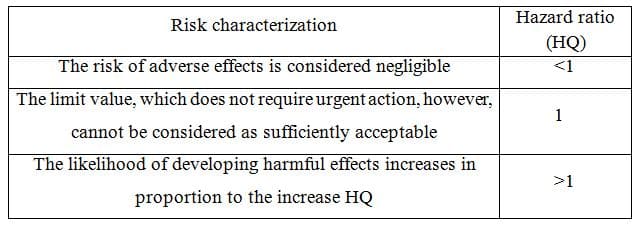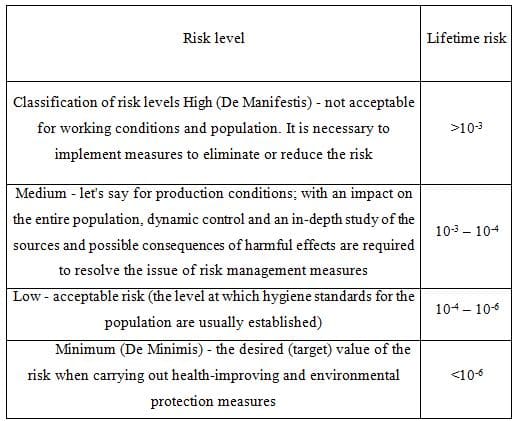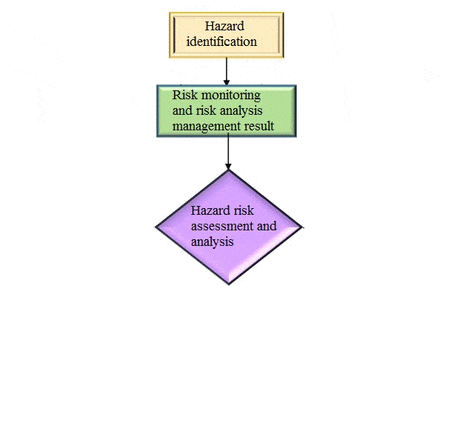Abstract
Content
- Introduction
- 1. Relevance of the topic
- 2. The purpose and objectives of the study
- 3. Review of literary sources
- 3.1 Environmental risk analysis
- 3.2 The impact of the enterprise on the environment
- 4. Assessment of environmental risks at the enterprise
- Conclusion
- References
Introduction
Donbass belongs to the industrial regions, the developed extraction of minerals and the availability of natural resources led to environmental and economic negative consequences.
At present, the concept of risk assessment in almost all countries of the world and international organizations is considered as the main mechanism for the development and adoption of managerial decisions both at the international, state or regional levels, and at the level of a separate production or other potential source of environmental pollution.
Assessment of risk to human health is a quantitative and / or qualitative characteristic of harmful effects that can develop as a result of the influence of factors of the human environment on a specific group of people under specific exposure conditions [6].
1. Relevance of the topic
Currently, on the territory of the Donetsk region, there are more than 600 waste dumps, of which about 140 are burning. Burning waste dumps with emission of dust and toxic gases, spontaneous combustion of rocks, landslides and even explosions of burning waste dumps pose a threat to human life and cause significant material damage. In the Donetsk region, a significant part of all waste dumps is located within the boundaries of mining agglomerations [2].
2. The purpose and objectives of the study
The aim of the study is to manage environmental risks while reducing the impact of a mining enterprise on the environment.
To achieve this goal, it is necessary to solve the following tasks:
- Conduct an environmental risk assessment at the enterprise.
- Predict the situation of environmental risks at the enterprise.
- Conduct an analysis of the company's impact on the environment.
- Conducting environmental protection measures to reduce environmental risks at the enterprise.
3. Review of Literary Sources
3.1 Environmental risk analysis
In modern conditions, the problems of rational use of the underground space of coal deposits in the national economy are of particular relevance. The shortage of the territory of settlements, environmental problems and economic feasibility dictate the necessary solutions for calculating the reuse of the underground space of mine workings.
The problem is most acute in the conditions of Donbass. This is due to:
- developed infrastructure;
- high population density;
- difficult ecological situation;
- the closure of unprofitable mines;
- the attractiveness of having ready–made objects;
- the ability to relieve the area where people live from technogenic influences and engineering structures
- the need to include in useful activities already committed costs, which, with their smooth development, will reduce the cost of primary and secondary production;
- the ability to ensure the safety of the technologies of some industries associated with the risk of significant pollution of the area where people are located [3].
Risk analysis involves identifying hazards, characterizing and assessing risk, analyzing risk and determining acceptability, and providing information for decision–making to reduce and control risk. The analysis should cover all stages of the life of a technogenic object: from creation to burial
of an exhausted technology and its elimination of harmful consequences. For example, the decision to build and operate a landfill should be made taking into account measures for its reclamation.
The main goal of risk analysis is to reduce it to an acceptable level. Therefore, risk analysis is ultimately aimed at decision–making and serves as a tool that allows for quantitative assessments that provide scientific credibility in the decision–making process. The most important element of risk analysis turns out to be hazard identification, where a conceptual model is created: there is no risk clearly without a formulated hazard or in its absence (Menshikov, 2014). Indeed, if the greatest danger is not taken into account, it is not included in the calculation of the risk, and, therefore, all calculations and conclusions on risk are erroneous.
Environmental risk assessment is a scientific study that uses facts and scientific predictions to assess potential harmful effects on the environment.
The main task of assessing environmental risks is to identify and assess the likelihood of occurrence of events that have adverse consequences for the environment. Risk assessment includes frequency analysis, impact analysis and their combination.
The effectiveness of risk assessment depends on the applied calculation methods, the availability of information (statistical data, etc.), the qualifications of specialists, etc.
Environmental risk management (risk management) is a decision–making process and is considered as a way to ensure environmental safety during the operation of man–made facilities.
In the risk assessment methodology, it is customary to focus on the harmful effect that occurs when exposed to the lowest of 22 effective doses (critical effect, critical organs / systems). At the same time, the international risk assessment methodology assumes that: – for non–carcinogenic substances and carcinogens of non–genotoxic action, it is assumed that there are threshold levels below which harmful effects do not occur; – carcinogenic effects due to the action of genotoxic carcinogenic factors, possible when exposed to any doses that cause damage to the genetic material; there are no threshold levels for this kind of compounds. To characterize the risk of developing non–carcinogenic effects, two indicators are most often used:
- maximum inactive dose;
- the minimum dose causing a threshold effect [1].
Criteria for non–carcinogenic risk are given in the table 1.
Table 1 — Non–carcinogenic risk criteria.

An assessment of health risks associated with exposure to air pollutants is given in Table 2; it is also advisable to focus on the system of criteria recommended in WHO publications (1996, 1999, 2000).
Table 2 — Assessment of health risks associated with exposure to air pollutants.

3.2 The impact of the enterprise on the environment
The most dangerous objects of the mining industry are coal mines. The largest accidents with socially significant consequences with a large number of injured workers have occurred in recent years at the coal industry facilities. Coal mining is carried out by mine and open–pit methods. In both cases, the displacement and mixing of waste rocks occurs, in the places where the rocks are stored after coal extraction, giant chemical reactors are again formed, in which various chemical reactions are resumed, long extinct in the natural underground conditions of methane – air atmosphere. The direction of these reactions, proceeding, as a rule, with the release of heat and gaseous substances, their nature and composition of the compounds formed in this case have not been sufficiently studied.
Negative factors associated with underground coal mining: & ndash; these are sudden outbursts of coal, rock and gas, rock bumps, rock mass collapses, flashes and explosions of methane gas, exogenous and endogenous fire hazard, the formation of a depression funnel & ndash; A zone of low pressure, formed in the formation around a production well and has the shape of a funnel.
According to the World Health Organization (WHO), 20% of economic damage from disease, disability and death is due to environmental quality. At the same time, about 7% of mortality among the urban population (on average 16 thousand deaths for a fifteen million population) living in the most polluted areas is due to the influence of polluted atmospheric air.
Determination of risk factors, bringing their role in human health disorders, as well as quantitative characteristics of the dependences of harmful effects on the levels of exposure to specific factors allows us to assess the real threat to the health of the population living in certain territories, and provides objective grounds for the implementation of preventive measures.
Assessment of the risk to public health from air pollution is necessary for decision–making in the planning, design, modernization, construction and reconstruction of industrial facilities; in the development and improvement of various technologies aimed at ensuring environmental safety and protecting the population of the territories from technological hazards.
4. Assessment of environmental risks at the enterprise
All methodological approaches to the analysis and assessment of risk can be conditionally divided into two groups.
The first group includes methods based on determining the frequency or likelihood of hazardous events and possible environmental damage based on the results of retrospective analysis of data and assessments of similar accidents and disasters that occurred earlier.
The second group consists of methods based on scientific and technical forecasting and modeling of the development of dangerous events, leading, ultimately, to man–made and environmental impacts, with the involvement of logical and probabilistic and other scientific methods [7].
The risk analysis process ends with the development of a recommendation to mitigate risks if the value of the risk exceeds an acceptable level, and control the risks while assessing the risk as acceptable. Environmental risk management is an integral part of enterprise risk management and is subject to general management principles (Figure 1) [8].

Figure 1 — Risk management processes
The stages of risk management are shown in the figure 2.

Figure 2 — Risk management stages
(animation: 9 frames, 5 repetitions, 184 kilobytes)
Risk management is based on the ability to effectively reduce environmental risk, taking into account the cost of activities.
After a number of major accidents in the second half of the 20th century, which led to significant environmental pollution, the direction of research on environmental risk began to develop intensively.
Among the variety of definitions of risk, there are three most common (classical) approaches according to which the risk can be expressed:
a) as a quantitative measure of hazard:
- maximum inactive dose;
- the minimum dose causing a threshold effect [1].
b) as a probabilistic measure of the occurrence of man–made or natural phenomena;
c) as the mathematical expectation of damage arising from accidents, disasters and dangerous natural phenomena [7].
The most common definition of risk as a probabilistic measure of a hazard (event, situation or condition).
The main elements of risk are:
- danger (damage or harm to the OS);
- uncertainty associated with a lack of information to quantify the outcome of an event and predict the development of the situation with the definition of damage.
Based on the analysis of various approaches to determining the content of the risk of industrial enterprises and its distinct features: risk is a situation with an uncertain development result determined by the probability of deviation of certain parameters from a given level, which leads to the need to address social and economic consequences from the activities of industrial enterprises.
Conclusions
Analysis and management of environmental risks is an important tool for monitoring the state of the environment, as well as choosing measures to reduce negative anthropogenic impact.
The work carried out an analysis of environmental risks. Analyzed the stages of risk management at the enterprise. The main negative consequences of the operation of a mining enterprise on the environment are considered. One of the most dangerous processes at a mining enterprise is the burning of waste dumps.
A quantitative analysis of the risk of long–term exposure to pollutants released into the air during the combustion of the waste dump of the mine named after M.I. Kalinin at the border of the Sanitary Protection Zone (SPZ) showed that the combined risk of exposure to sulfur dioxide and hydrogen sulfide is 0.501, which also corresponds to the occurrence of severe chronic effects in the population.
To prevent emissions of pollutants during the combustion of the waste dump of the mine named after M.I. Kalinin, timely measures are needed to extinguish the centers of spontaneous combustion at an early stage of combustion, which can be used for remote monitoring of the thermal state of waste dumps using thermal imagers, unmanned aerial vehicles and gas analyzers.
References
- Караева, Н. В., Варава, И. А. Методы и средства оценки риска здоровья населения от загрязнения атмосферного воздуха: Учеб. пособие. для студ. специальности
Компьютерные науки и информационные технологии
, специализацииИнформационные технологии мониторинга окружающей среды
/ Н. В. Караева, И. А. Варава // КПИ им. Игоря Сикорского. – Киев, 2018. – 56 с. - Козырь, Д. А. Усовершенствование методов контроля температуры при обеспечении экологической безопасности породных отвалов угольных предприятий [Текст] / Д. А. Козырь // Проблемы природопользования и экологическая ситуация в Европейской России и на сопредельных территориях: Материалы VII Междунар. науч. конф. 24–26 октября 2017 г. – Белгород: Изд–во
ПОЛИТЕРРА
, 2017. – С. 339 – 342. - Ю. В. Зеленов, Ю. И. Бията, Проф., к. т. н., В. Н. Артамонов. Выявление экологических рисков при закрытии шахт и обоснование направлений по их преодолению. Збірник наукових праць студентів і аспірантів
Екологічні проблеми топливно–енергетичного комплексу
, (24–25 квітня 2013 р., Донецьк): Зб. матер. конф. / ред. О. В. Луньова – Донецьк, ДонНТУ, 2013 р. – 105 с. - Р 2.1.10.1920–04 Руководство по оценке риска для здоровья населения при воздействии химических веществ, загрязняющих окружающую среду, РФ, 2004 / URL: http://docs.cntd.ru/document/1200037399
- Высоцкий, С. П. Контроль экологического состояния породных отвалов [Электронный ресурс] / С. П. Высоцкий, Д. А. Козырь // Вестник Донбасской национальной академии строительства и архитектуры. – Макеевка: ДонНАСА, 2018. – Вып. 2018–3 (131). – С. 12 – 18.
- И. А. Тимоханова, Проф., к. т. н., В. Н. Артамонов. Совершенствование системы управления экологическими рисками при закрытии шахт: анализ, выявление, учет. Донецк, ДонНТУ, 2019 р. – 128 с.
- Хованский А. Д, Богачев И. В., Баян Е. М. Экологическая безопасность (методы оценки и обеспечения): учебное пособие / А. Д. Хованский, И. В. Богачев, Е. М. Баян; Южный федеральный университет. – Ростов–на–Дону: Издательство Южного федерального университета, 2015. – 162 с.
- О. Д. Грачева Проф., к. т. н., В. Н. Артамонов. Совершенствование системы управления экологическими рисками в условиях действующей шахты. Донецк, ДонНТУ, 2019 р. – 107 с.
